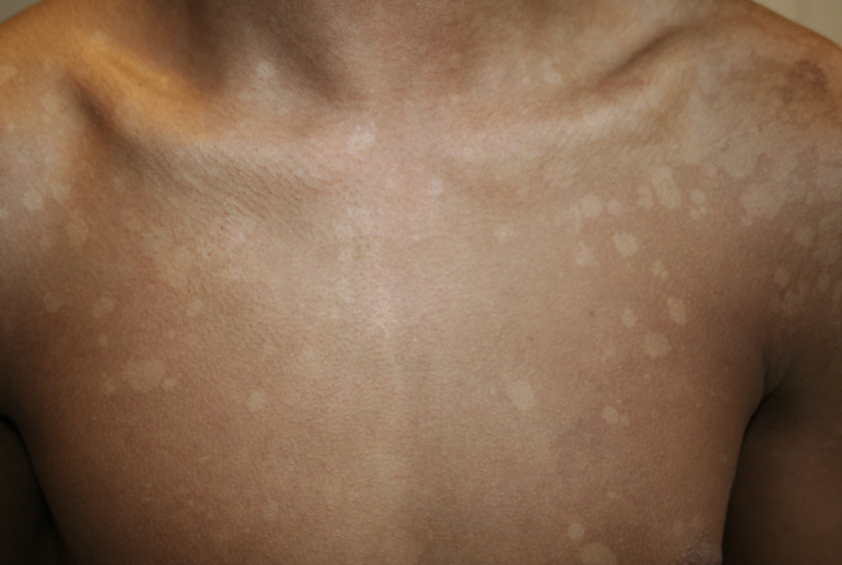Sunburn Chest Rash? Understanding Skin Reactions After Sun
Has your chest ever erupted in a rash of red spots after a day in the sun? It's a frustratingly common experience, especially during the summer months. That tender, itchy feeling can put a damper on any outdoor fun. So, what causes these pesky spots, and what can you do about them?
Red spots on the chest following sun exposure are often a sign of sunburn. This occurs when the skin's protective barrier is overwhelmed by ultraviolet (UV) radiation from the sun. The UV rays damage the skin cells, leading to inflammation and the characteristic redness, warmth, and sometimes even blistering. However, sun-related skin irritations can manifest in different ways, from a mild pinkish flush to a more severe rash. Understanding the various reactions is key to protecting your skin.
For centuries, humans have both basked in the sun's warmth and suffered its consequences. While sunlight is essential for vitamin D production and overall well-being, excessive exposure can be detrimental. Historically, people relied on natural remedies like aloe vera and cool compresses to soothe sunburned skin. Today, we have a better understanding of the science behind sun damage and the importance of sun protection. The main issue with these skin reactions is not just the immediate discomfort, but also the long-term risks associated with repeated sunburns, including premature aging and an increased risk of skin cancer.
A simple sunburn on the chest typically appears as a reddish or pinkish area that's sensitive to the touch. It might also feel warm or even hot. A sun rash, on the other hand, might present as small, red bumps or a more widespread area of redness and irritation. Sometimes, a sun allergy can trigger a more intense reaction known as polymorphous light eruption (PMLE), characterized by itchy, raised bumps or blisters. It’s important to note that if you experience any unusual or severe skin reaction after sun exposure, it’s always best to consult a dermatologist.
While these reactions are primarily caused by overexposure to the sun, individual skin type plays a significant role. People with fairer skin are generally more susceptible to sunburn and sun rashes. Other factors, like certain medications or underlying health conditions, can also increase sensitivity to the sun. It’s essential to be aware of your individual risk factors and take appropriate precautions.
If you're unsure if your red spots are a simple sunburn or something else, it's always best to consult a medical professional. They can diagnose the specific issue and recommend the appropriate treatment.
Tips for soothing a sunburned or irritated chest include applying cool compresses, taking lukewarm baths with colloidal oatmeal, and using gentle, fragrance-free moisturizers. Avoid harsh soaps and exfoliants, and protect the area from further sun exposure.
Advantages and Disadvantages of Recognizing Sun-Related Skin Reactions
| Advantages | Disadvantages |
|---|---|
| Early identification allows for prompt treatment and relief. | Can be difficult to distinguish between different types of skin reactions. |
| Promotes awareness of sun safety and preventative measures. | May lead to unnecessary anxiety if mild reactions are misinterpreted. |
Frequently Asked Questions:
1. What can I do to prevent red spots on my chest after sun exposure? Answer: Use a broad-spectrum sunscreen with an SPF of 30 or higher, reapply every two hours, and wear protective clothing.
2. How long does a sunburn typically last? Answer: A mild sunburn can last a few days, while a more severe burn can take a week or longer to heal.
3. Can I use aloe vera on a sunburn? Answer: Yes, aloe vera can help soothe sunburned skin.
4. Should I see a doctor for a sunburn? Answer: If you have a severe sunburn with blistering, fever, or chills, seek medical attention.
5. What is polymorphous light eruption (PMLE)? Answer: PMLE is a type of sun allergy that causes an itchy rash.
6. How can I tell if I have a sun allergy? Answer: A sun allergy can manifest as an itchy rash, hives, or blisters after sun exposure.
7. Can certain medications make me more sensitive to the sun? Answer: Yes, some medications can increase sun sensitivity.
8. What is the best way to protect my skin from the sun? Answer: Use sunscreen, wear protective clothing, and seek shade during peak sun hours.
In conclusion, experiencing red spots or a rash on your chest after sun exposure can be a common yet uncomfortable occurrence. Understanding the underlying causes, whether it's a simple sunburn or a more complex reaction like PMLE, empowers you to take the necessary steps to protect your skin. Prioritizing sun safety through preventative measures like sunscreen application and limiting sun exposure during peak hours is crucial. Promptly addressing any skin reactions with soothing remedies can alleviate discomfort and promote healing. Recognizing the importance of sun protection not only ensures a more enjoyable time outdoors but also safeguards your skin's long-term health and reduces the risk of future complications.
Pizza hut in albany ny your guide to the hut
Que es la prepotencia en una persona unmasking arrogance
Squeezing style into square feet modern farmhouse small bathroom ideas












